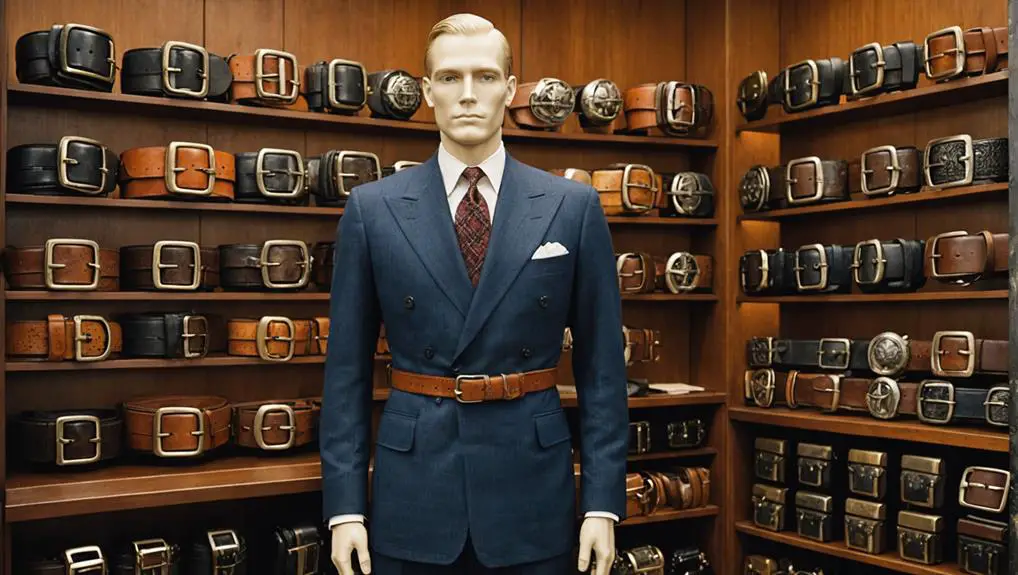In the 1930s, men's belts transformed into significant style elements, blending function with aesthetic appeal. You'd find leather belts, typically about 1 3/8 inches wide, showcasing durability and sophistication. The Garrison belt, popular among uniformed professionals, featured a practical two-prong design, while sport belts offered colorful braided options for casual wear. Ornate Art Deco patterns adorned many belts, reflecting the era's artistic trends. With adjustable lengths and unique buckles, these accessories added a refined touch to men's outfits. Explore how these belts fit into a broader context of 1930s fashion, enriching your understanding of this fascinating era.
Overview of 1930s Men's Belts
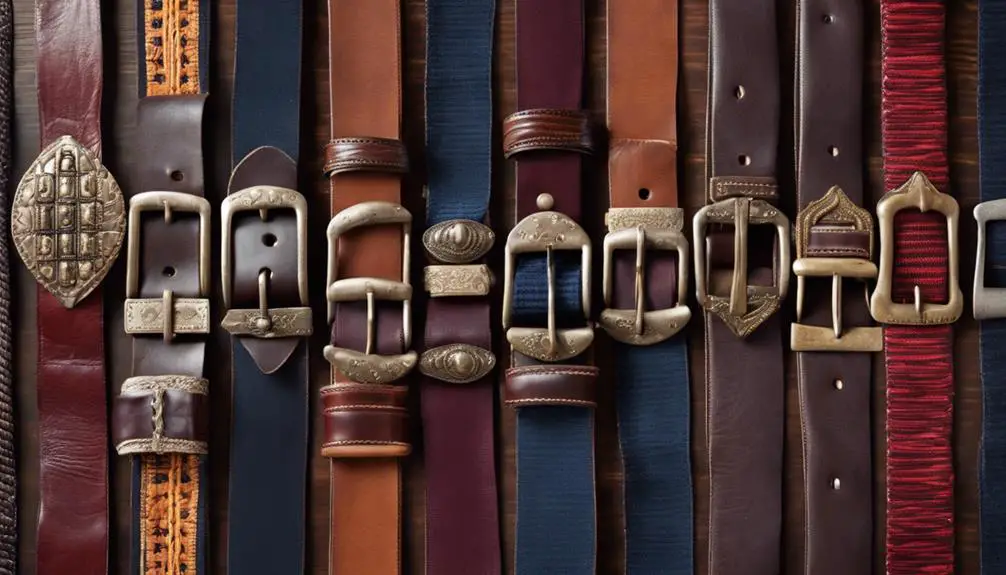
In the 1930s, men's belts shifted from mere functional accessories to pivotal elements of style, reflecting the evolving fashion landscape of the decade. Leather belts became synonymous with both utility and aesthetic appeal, marking a significant change in men's fashion. You'd notice that these belts often featured wide designs, typically around 1 3/8 inches in width, accommodating both formal and casual attire seamlessly.
During this era, the Garrison belt gained traction, characterized by its wide two-prong design, popular among uniformed professionals who valued both style and functionality. This belt not only served a practical purpose but also conveyed authority and sophistication. Meanwhile, sport belts emerged, crafted from colorful braided or pierced leather, perfect for the warm summer months and casual outings.
Men's belts of the 1930s showcased a unique blend of functionality and aesthetics, as they were increasingly matched to ensembles to create a polished look. This modification underscored the importance of personal style in men's fashion, where leather belts became not just a necessity but a statement piece, reflecting broader trends in society and culture during this dynamic decade.
Types of Belts
Exploring the types of belts from the 1930s reveals a fascinating intersection of fashion, function, and personal expression. During this era, leather belts stood out for their durability and classic appeal, typically measuring 1 3/8 inches wide and adorned with solid brass buckles. These belts became a staple, seamlessly complementing various outfits.
You'd also find garrison belts, which were popular among uniformed professionals. Their wide two-prong design not only offered a distinct look but also served practical purposes. For a more casual vibe, sport belts emerged, featuring colorful braided or pierced leather options that perfectly suited summer attire.
As fashion evolved, decorative belts gained prominence, showcasing intricate designs inspired by Art Deco motifs and bejeweled buckles. These belts transformed into statements of elegance, adding flair to any ensemble. Yet, functionality remained vital; utility belts were designed for carrying tools, while specific activity belts catered to sports and outdoor pursuits. This blend of style and practicality guaranteed that belts in the 1930s weren't just accessories—they were essential components of a man's wardrobe, reflecting both individuality and purpose.
Materials Used in Belt Production

Crafting men's belts in the 1930s involved a careful selection of materials that balanced durability and style. The era's belts were not just functional; they were also fashion statements. The most common material was cowhide leather, prized for its flexibility and longevity. You'll find that many belts featured decorative elements like brass belt buckles, which added a touch of sophistication and character.
Here are four notable materials used in belt production during the 1930s:
- Cowhide Leather – Durable and flexible, perfect for everyday wear.
- Fabric – Woven and braided options became popular, especially for casual summer outfits.
- Metal – Gold tone and silver were often incorporated into buckles, reflecting the Art Deco aesthetic.
- Handcrafted Touches – Attention to stitching and embellishments showcased exceptional craftsmanship.
This combination of materials not only fulfilled practical needs but also aligned with the fashion trends of the time, making belts a key accessory in men's wardrobes. Each belt, with its unique buckle and design, told a story of style and elegance that defined the decade.
Popular Styles and Designs
Men's belts in the 1930s truly embraced a range of styles and designs that reflected the era's dynamic fashion landscape. You'd notice a strong emphasis on prong leather belts, featuring a variety of materials and aesthetics. The Garrison belt, with its wide two-prong design, captured attention, especially among uniformed professionals, merging functionality with flair.
Vintage leather belts typically measured around 1 3/8 inches wide, often paired with large decorative buckles that made bold statements. This trend towards eye-catching accessories highlighted a desire for individuality and style. The influence of the Art Deco movement created ornate designs with geometric patterns and luxurious materials, which added a touch of sophistication to men's wardrobes.
Casual options also emerged, catering to a more relaxed lifestyle. Sport belts made from colorful braided or pierced leather became staples for summer attire, allowing men to express their personalities beyond formal wear. This blend of casual and formal styles showcased the versatility of men's belts during the decade, making them essential accessories that complemented a wide array of outfits while reflecting contemporary fashion sensibilities.
Functional Features of Belts
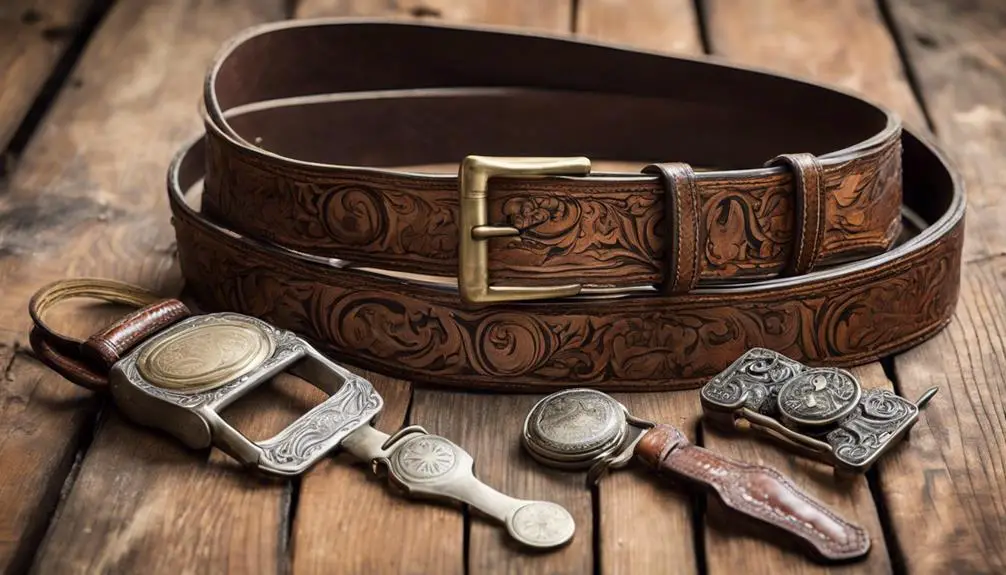
In the 1930s, belts were more than just fashion statements; they played an essential role in ensuring comfort and functionality. As you wore them, you'd notice they provided a secure fit for your trousers while enhancing your overall attire. The functional features of belts during this era were designed with the wearer in mind, focusing on practicality. Here are some key aspects:
- Adjustable Lengths: Most belts came with multiple holes, allowing you to customize the fit for varying waist sizes.
- Belt Loops: The emergence of belt loops on trousers made wearing belts much more convenient, reducing reliance on suspenders.
- Specialty Designs: Military personnel often wore Garrison belts, which featured wide prongs for added security, combining function with uniformity.
- Decorative Elements: While functionality was key, belts also showcased embossed designs and unique buckles, blending utility with personal style.
These features made belts indispensable in men's wardrobes, ensuring they served both a practical purpose and a touch of flair in everyday fashion.
Fashion Trends Influence
Throughout the 1930s, one could see how fashion trends considerably influenced men's belts, transforming them from mere utilitarian items into key components of style. The Art Deco movement, with its bold geometric patterns and luxurious materials, permeated men's fashion, resulting in decorative leather belts that became essential accessories. You'd notice that cowhide leather belts, often around 1 3/8 inches wide, sported wide, embellished buckles that captured the era's aesthetic. This period also saw the emergence of unique label designs on belts that reflected the craftsmanship and high-quality materials typical of the time, showcasing elements akin to those found in vintage clothing labels.
Belts evolved beyond their traditional roles; they became fashion statements that complemented various styles. For instance, Garrison belts were favored by uniformed professionals, while sport belts adorned casual summer outfits. The introduction of belt loops in trousers during this decade further solidified belts as a staple, enhancing their versatility in styling.
As you explore vintage fashion from the 1930s, it's clear that belts were not just functional but integral to a coordinated look. Men began focusing on matching their belts with shoes and other accessories, showcasing a newfound attention to detail and personal style. This shift highlights how the influence of contemporary fashion trends reshaped the perception and purpose of men's belts during this vibrant decade.
Belt Accessories and Complementary Items
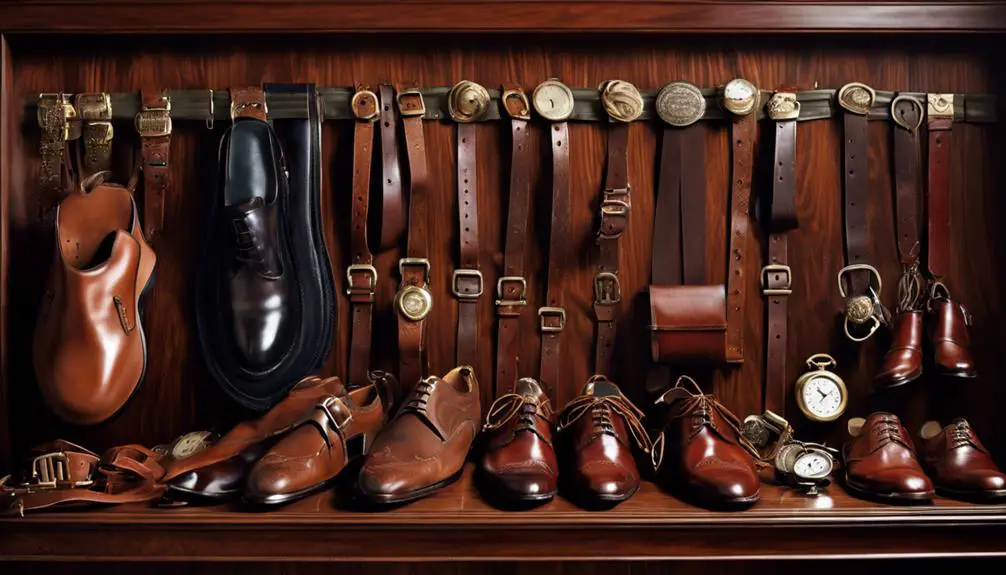
The evolution of men's belts in the 1930s naturally led to a rise in complementary accessories that enhanced overall style. As you donned your leather belt, typically measuring 1 3/8 inches wide and adorned with decorative buckles, you also embraced other items that contributed to a cohesive look. These accessories didn't just serve a purpose; they reflected personal flair and sophistication.
Here are four vital belt accessories and complementary items you might consider:
- Cufflinks: These small but impactful accessories added a touch of elegance to your shirt cuffs, harmonizing with the belt's aesthetic.
- Tie Clips: By securing your tie, these clips not only kept your look sharp but also matched the buckle's design, enhancing your overall outfit.
- Pocket Squares: Coordinating a pocket square with your belt's color introduced an element of stylish coordination that was essential in the 1930s.
- Garrison Belts: With their wide two-prong buckles, these belts offered both functionality and style, fitting seamlessly into your high-waisted trousers and belt loops.
Together, these elements defined a well-rounded, fashionable appearance.
Notable Brands and Manufacturers
During the 1930s, several notable brands and manufacturers stepped up to shape the landscape of men's belts, each leaving a distinct mark on fashion history. Major players like Brooks Brothers and Levi Strauss were renowned for their quality leather belts, while military uniform suppliers introduced the Garrison belt, reflecting the utilitarian style favored by enlisted men.
Innovative brands like J.P. Coats and H.G. Lawrence embraced the era's Art Deco movement, integrating decorative elements into their designs. This shift catered to a growing consumer interest in style, showcasing bold geometric patterns and unique embellishments. Additionally, smaller artisanal brands emerged, emphasizing handcrafted leather goods that highlighted craftsmanship and individual style.
Here's a glimpse of some notable brands and their contributions:
| Brand | Notable Features | Influence |
|---|---|---|
| Brooks Brothers | Quality leather belts | Timeless elegance |
| Levi Strauss | Durable construction | Workwear practicality |
| J.P. Coats | Decorative elements | Fashion-forward appeal |
| H.G. Lawrence | Art Deco patterns | Trendsetter in style |
These brands illustrate how the 1930s marked a significant evolution in men's belts, blending utility with artistry.
Collecting Vintage Belts
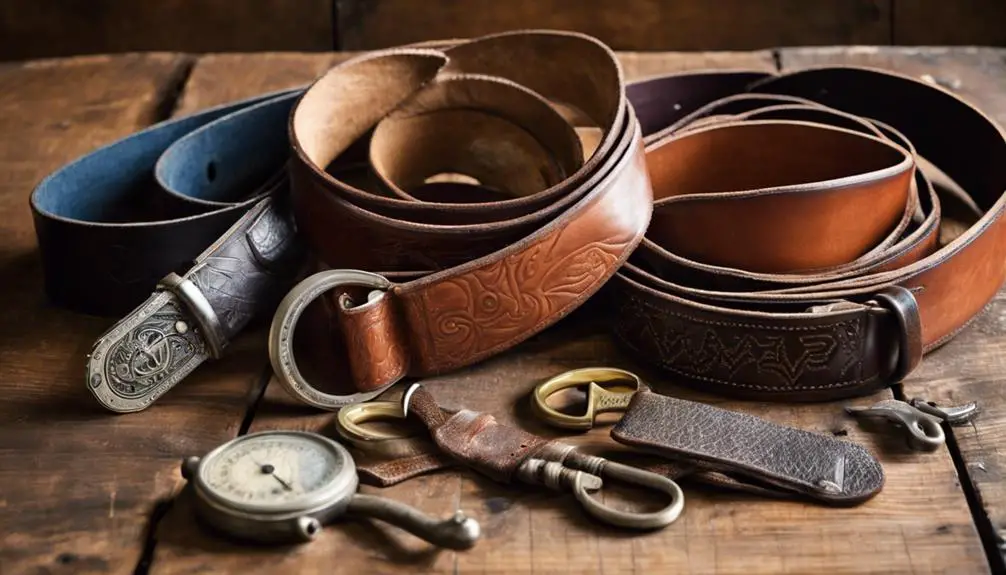
Nostalgia for the past drives many collectors to seek out vintage belts from the 1930s, a decade rich in fashion innovation and cultural shifts. Collecting these pieces not only taps into early 20th-century aesthetics, but also reveals the craftsmanship and unique designs that defined the era. When you're on the hunt, keep these key factors in mind:
- Design Style: Focus on specific styles like Art Deco, known for intricate patterns and luxurious materials.
- Rarity and Condition: Prices can range from $25 to $299, influenced by how rare or well-preserved the belt is.
- Historical Significance: Look for belts made by notable brands or those with unique design elements to enhance value.
- Marketplace Variety: Explore online platforms and vintage stores, where you can negotiate prices and discover hidden gems.
Each vintage belt you collect acts as a tangible link to the past, enriching your understanding of 1930s fashion. By appreciating these unique pieces, you not only celebrate personal style but also the cultural narrative embedded in early 20th-century fashion history.
Frequently Asked Questions
Did Men Wear Belts in the 1930s?
Yes, men wore belts in the 1930s. You'll find they evolved from mere functional items to stylish accessories, featuring leather materials and decorative buckles, complementing outfits while reflecting personal style and changing fashion trends.
What Kind of Ties Did Men Wear in the 1930s?
In the 1930s, you'd notice men wearing striking silk ties, typically featuring bold patterns like stripes and polka dots. These ties often showcased vibrant colors, adding flair and individuality to their polished outfits.
When Did Men Start Wearing Belts?
You'll find that men started wearing belts prominently in the early 20th century. As trousers evolved to include belt loops, belts shifted from functional items to stylish accessories, enhancing both fit and aesthetic.
How to Dress Like the 1930S Men?
To dress like 1930s men, opt for high-waisted trousers with suspenders, a fitted jacket, and polished leather shoes. Don't forget a silk pocket square and cufflinks to complete your sophisticated, vintage-inspired look.
